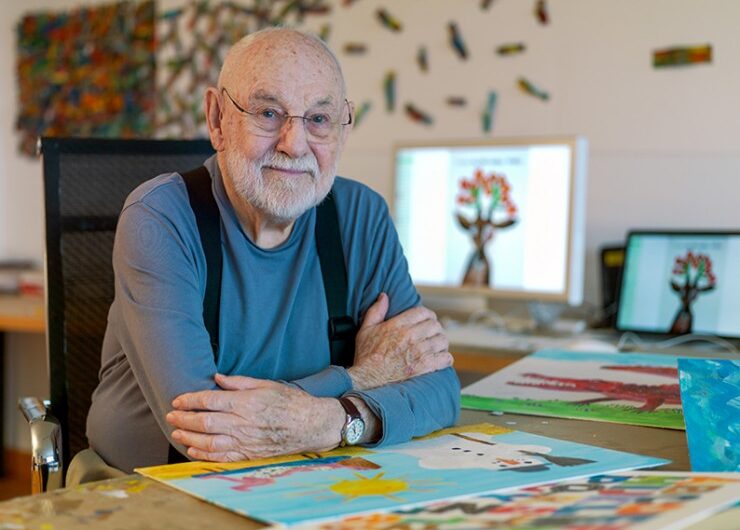“Gorgeously illustrated, brilliantly innovative presentation of an insect’s appetite and metamorphosis,” The New York Times wrote of Eric Carle’s “The Very Hungry Caterpillar,” when naming the book among the “outstanding [children’s] books of the year” for 1969.
The 14-page book depicts a caterpillar that eats his way through an apple, pears, plums, strawberries, oranges, cake, ice cream, a pickle, Swiss cheese, salami, pie, watermelon, and “one nice green leaf.” First published in 1969, it’s gone on to sell more than 50 million copies.
“I think it is a book of hope,” Carle once said. “Children need hope. You, little insignificant caterpillar can grow up into a beautiful butterfly and fly into the world with your talent.”
Carle died Sunday, May 23, at age 91, at his summer studio in Northampton, Massachusetts, surrounded by family members, his publisher, Penguin Young Readers, reported. In addition to creating many beloved children’s picture books, in 2002, Carle and his wife Bobbie, who died in 2015, founded The Eric Carle Museum of Picture Book Art in Amherst, Massachusetts.
Carle was born June 25, 1929, to German immigrant parents in Syracuse, New York. His father often took him for walks in nature—seeing bugs and worms and bees that would, years later, inspire his books.
In 1935, when Carle was 6, his family returned to Germany, then under the control of the Nazis. Much modern art was deemed “degenerate” by the Nazi regime, so Carle was wowed when his high school art teacher, Friedrich Krauss, secretly showed him images of expressionist art that had been banned. Including the brilliant colors of paintings by Franz Marc, which would be a touchstone.
After graduating from art school in Stuttgart, where Carle learned collage, he moved to New York in 1952, was drafted into the U.S Army during the Korean War and was stationed near his parents’ home in Germany.
He eventually found work as a graphic designer in the promotion department for The New York Times and then, for many years, as an advertising agency art director.
Carle’s first book was “Brown Bear, Brown Bear, What Do You See?” The 1967 book was written by Bill Martin Jr., who sought Carle out after seeing an advertising illustration he’d made of a red lobster.
“It took five or six years for me to make enough money to live a very modest life,” Carle told The New York Times in 1994.
Since then Carle has illustrated more than 70 books—also authoring most of them. They were created in his distinctive technique of assembling images out of brilliantly colored, hand-painted papers that he cut up and collaged. (“I don’t know how to paint,” he told The Boston Globe in 1989.) He filled file cabinets with papers sorted by pattern and color.
Carle settled in Hawley, Massachusetts, in 1974 and later lived in Northampton. In retirement, he found a home in the Florida Keys.
“My books are not simple,” Carle told the Globe in 1989. “I devote my entire life to them, and I don’t do anything else. I think a lot. My books take a very long time. I may work two to three years on an idea. I start with 2,000 words, and reduce them to 20.”
Carle told The New York Times in 1994, “The success of my books is not in the characters or the words or the colors, but in the simple, simple feelings.”
If this is the kind of coverage of arts, nature, cultures and activisms you appreciate, please support Wonderland by contributing to Wonderland on Patreon. And sign up for our free, (hopefully) weekly newsletter so that you don’t miss any of our reporting. (All content ©Greg Cook 2021 or the respective creators.)
